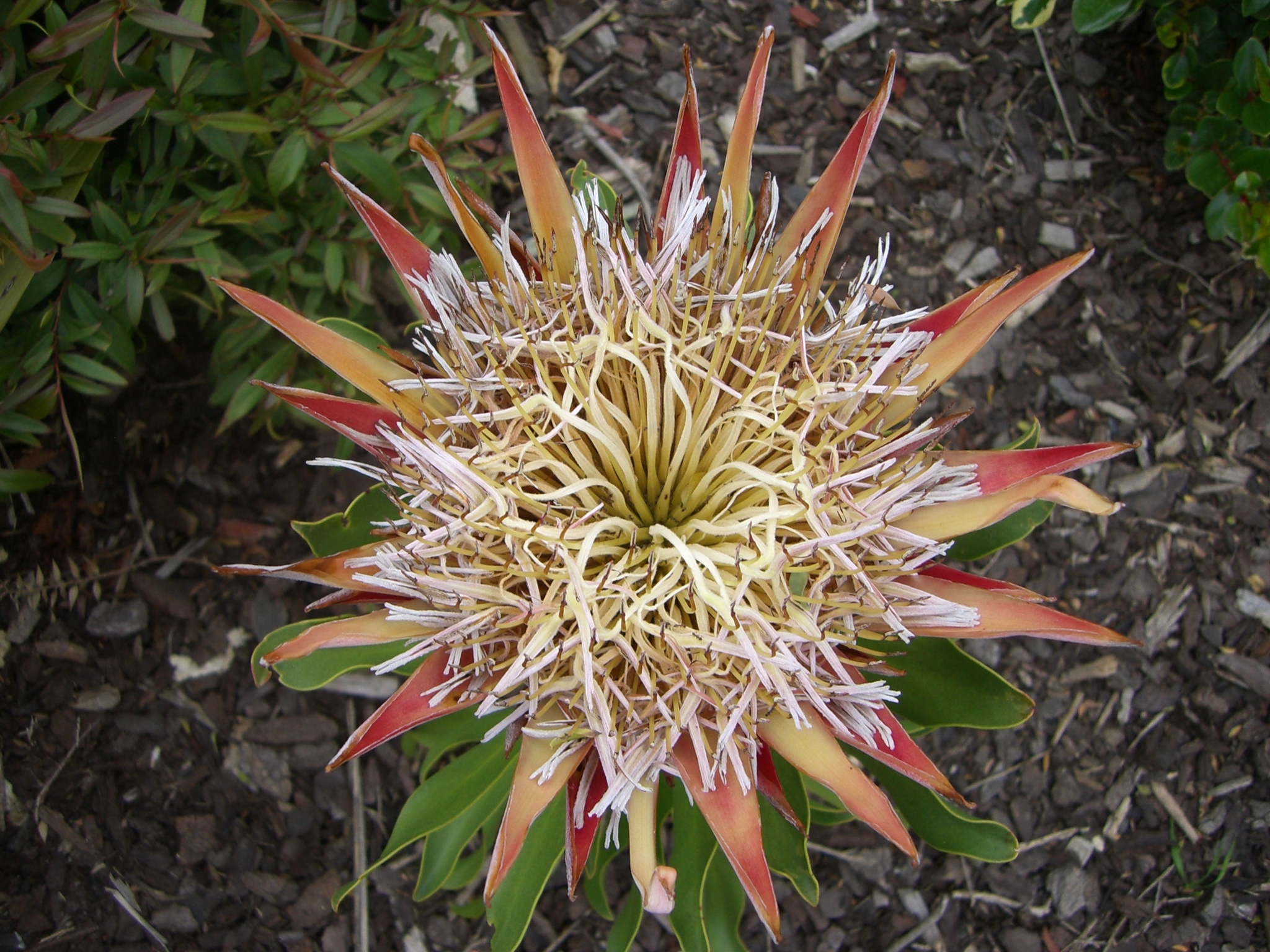
From the name Proteus, an ancient Greek sea God with the ability to change form; referring to the great variability of the species in this genus.
Prostrate to erect shrubs and small trees, some with lignotubers. Leaves entire, leathery. Flower heads terminal or occasionally axillary and in groups, often with colourful bracts that may have coloured hair, the flowers contained within these. Flowers bisexual, irregular, perianth segments 4, 3 fused, the remaining 1 spreading as the flower opens. Style straight or curved. Fruit an achene.
Mostly shrubs, grown for the spectacular and colourful cone-like flower heads with colourful buds and waxy, fringed bracts popular as cut flowers. Species from the winter rainfall zone of S Africa are cultivated and many of these are endangered in their natural habitat.
The collective name 'proteas' is generally used to indicate S African genera, the genus Protea itself sometimes being distinguished by the common name Sugarbush.
Very few species of Protea were listed in 19th century nursery catalogues. Interest in S African Proteaceae gathered momentum in the early 1900s, when soldiers returning from the Boer War brought small quantities of seed home with them. However, it was not until the mid-1970s that seed of a wide number of species was imported and some proteas were planted for commercial production. Protea and Leucospermum were introduced first, then Leucadendron. It was at this stage that Peter Mathews established Proteaflora Nsy which was to play an important role in developing the cut flower industry in Australia. Proteaflora pioneered the introduction of new cultivars, advised cut flower growers on cultivation methods, established the first Protea flower marketing cooperative and encouraged the establishment of the International Protea Association in 1981 (the IPA coordinates and initiates research and focuses the activities of all involved in the Protea industry). Proteaflora also introduced these plants to home gardeners by holding festivals in 1984 and 1985 and has agreements with breeders and selectors to trial and commercialise new varieties. Proteas are now an important element of Australian floristry and the home garden landscape. The following are important floristry plants: Protea 'Pink Ice'; Protea compacta hybrids; Protea neriifolia; the Leucadendron cultivars 'Pisa', 'Red Devil', 'Silvan Red' and L. laureolum; Leucospermum cordifolium and the cultivars 'Firewheel' and 'Tango'; and Serruria florida. These are marketed not only in Melbourne and Sydney but also Japan, Taiwan, Singapore, Hong Kong, USA and to a lesser extent Europe, where Australia competes with cheaper products from S Africa.
About 115 species from tropical and southern Africa. About 70 are endemic to the SW and SE Cape in a narrow coastal belt,while about 45 species occur to the north of this, about 13 from the summer rainfall zone of southern Africa.A further 35 or so are from central and tropical Africa.
Seed or semi-hardwood cuttings.
Flowers in large flat-topped heads with many basal bracts. Differs from the other S African genera Leucadendron and Leucospermum in having leaves not notched at the tip, and flower heads with shield-like bracts at the base.
Beard (1958, 1963, 1992), Rourke (1982), Matthews (1993), Sadie (2000, International Protea Register, 4th edn with Suppl.). For commercial aspects there is Growing and Marketing of Proteas, a 3- volume set of the 2nd, 3rd and 4th International Protea Conferences in 1983, 1985 and 1987 and the IPA1991 Sixth Biennial Conference Proceedings.
Source: (2002). Proteaceae. In: . Horticultural Flora of South-eastern Australia. Volume 3. Flowering plants. Dicotyledons. Part 2. The identification of garden and cultivated plants. University of New South Wales Press.

A'Joey' Flower cluster obovate, grey-red, yellowish green towards the base, the inner bracts hooked at the tips. Florets forming a spiral mass; late winter to early spring. A P. amplexicaulis hybrid. Raised Proteaflora and released in 1996. PVJ 7(4)40.
A 'Pink Princess' Flower head broad-obovate, purple-red, innermost bracts narrowly spoon-shaped with dense white hair on the margins and tips; floret mass grey-orange. P. magnifica _ P. compacta. PBR name released 1998,A.Mathews, Australia. PVJ 10(2)57. Also A'Pink Cupid',A'Pink Pride',A'White Mist' and A'White Night', all PVJ 11(4)53.
A 'Possum Magic' P. longifolia _ P. magnifica. Raised at Proteaflora and PBR granted in 1994, int. 1995. PVJ 7(1)32.
A P. longifolia hybrid with a pink flower cluster, the inner bracts with a white fringe and flower mass pink; Feb-May, Sept-Oct. Raised by Proteaflora in 1989.
Flower head pink; autumn, winter. P. compacta hybrid released by Proteaflora in 1995.
Raised by Protea Australis, Matthews, 1993.
Flower cluster clear red with silver tints. Florets deep rose-red. P. burchellii × P. magnifica. Raised Protea Australis, Matthews, Australia, 1993.
Flower head pink, white-fringed with black tufts; floret mass pink, centre wine red. H.Wood. P. magnifica hybrid from s Africa.
Flower cluster deep pink with silvery hair. Florets pink with a deep red centre, slightly pointed. P. compacta × P. suzannae. Raised Proteaflora, p. Matthews, Australia, c. 1981 and promoted internationally in 1987. Syn. ['Silvan Pink', 'Camelot'.
Raised Central Coast Protea and Waratah, 1996.